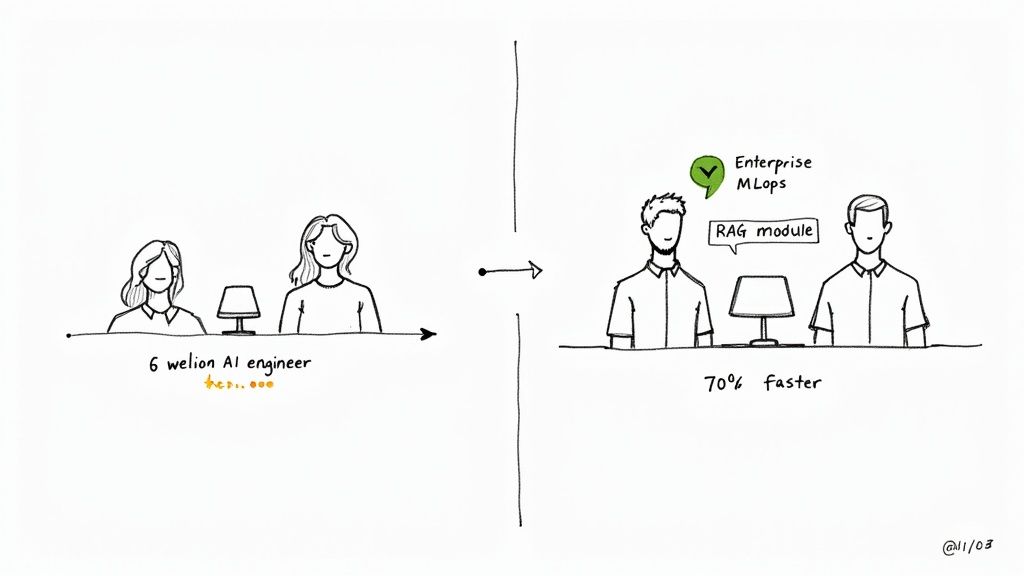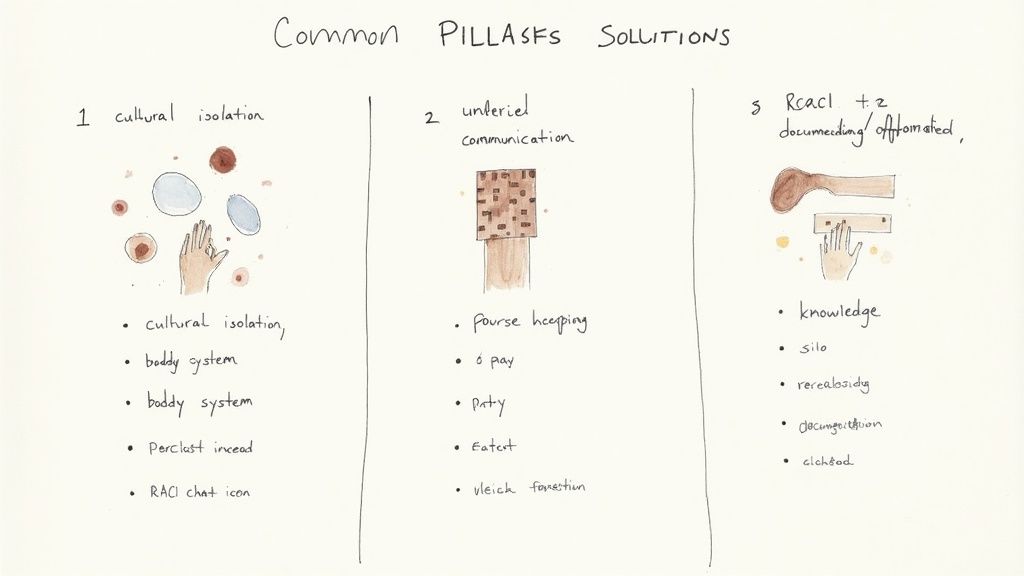TL;DR:
- What it is: A staff augmentation company provides vetted technical experts (like AI/ML engineers) who integrate directly into your team, under your management. It’s for speed and control.
- When to use it: Use it to fill critical skill gaps quickly, accelerate a project with a tight deadline, or scale your team for a specific period without the overhead of direct hires.
- How to choose: Vet partners on their technical screening process, the depth of their AI talent pool, and contract flexibility (e.g., replacement guarantees). Use a scorecard to compare vendors objectively.
- Key action: Define clear performance metrics (KPIs) in your contract, focusing on outcomes like sprint goal alignment and deployment frequency, not just hours worked.
Who This Guide Is For
This guide is for technical leaders and hiring managers who need to act fast:
- CTOs / Heads of Engineering who need to add specialized AI or MLOps talent in weeks, not months, to hit a critical product deadline.
- Founders / Product Leads scoping roles and budget for a new AI feature and need to de-risk the project by bringing in proven expertise.
- Talent Ops / Procurement evaluating vendors and need a practical framework for vetting partners and structuring contracts for success.
Quick Framework: When to Use Staff Augmentation
Choosing the right hiring model is a make-or-break decision. Staff augmentation gives you a flexible lever to pull, bringing in top-tier AI and engineering talent without the months-long process and fixed costs of traditional recruiting. The model is built for two things: speed and control. You direct your augmented team members just like you would any other employee.
But it’s not the only option. It's crucial to understand how it stacks up against alternatives like managed services (outsourcing) and traditional direct hires. Getting this right depends on your project's timeline, budget, and how hands-on you want to be. For a deeper look at how this compares to other development models, check out our guide on outsourced development and staff augmentation.
Use this decision table to make the right call based on your primary business driver.
This comparison makes it clear: if you need direct project control and must move quickly, staff augmentation is your most effective option.
 alt text: Infographic comparing staff augmentation, managed services, and direct hires across speed, cost, and control.
alt text: Infographic comparing staff augmentation, managed services, and direct hires across speed, cost, and control.
When it comes to finding the right people, modern tools that use AI skills mapping for technical profiles can help pinpoint the perfect candidate even faster within this model.
Practical Examples of Staff Augmentation
It’s one thing to talk about staff augmentation in theory, but what does it look like on the ground? Let's walk through two real-world examples that show how a staff augmentation company gets projects over the finish line and delivers measurable business impact.
 alt text: A team collaborating around a whiteboard, illustrating a successful staff augmentation project delivery.
alt text: A team collaborating around a whiteboard, illustrating a successful staff augmentation project delivery.
Example 1: Launching a RAG Pilot in Six Weeks
Scenario: A mid-stage SaaS startup needs to build a Retrieval-Augmented Generation (RAG) system for a new AI chatbot. Their internal team is strong on backend development but has no experience with Large Language Models (LLMs) or vector databases. A critical Q3 product launch is looming.
Traditional hiring would have taken months they didn't have. Instead, they partnered with a staff augmentation firm to bring in two senior AI engineers.
- Team Structure: The two augmented engineers slotted directly into the startup’s existing team, working alongside three backend developers and a product manager. They reported to the company's Head of Engineering.
- Communication Flow: They operated as a single agile squad with daily stand-ups, shared Slack channels, and joint sprint planning. This tight integration ensured seamless knowledge sharing.
- The Business Outcome: By injecting specialized expertise directly where it was needed, the startup went from concept to a functional RAG pilot in six weeks. This de-risked their product roadmap and kept the launch on schedule—an outcome impossible with a traditional hiring cycle. The key was speed-to-value.
Example 2: Cutting ML Model Deployment Time by 70%
Scenario: A large fintech enterprise was stuck with a slow, manual process for deploying machine learning models. Every update took weeks to get into production, creating a massive bottleneck for their data science teams. They knew they needed a solid Machine Learning Operations (MLOps) foundation, fast.
They augmented their platform engineering team with three MLOps specialists. The goal was to automate the entire model lifecycle.
- The Intervention: The augmented experts designed and built a full Continuous Integration/Continuous Deployment (CI/CD) pipeline using Jenkins, Docker, and Kubernetes.
- The Business Impact: Within three months, the new pipeline cut model deployment time from an average of four weeks down to a few days—a 70% reduction in time-to-market for new model features.
- The ROI: This was not just a technical win. The data science team could finally iterate quickly, improve model accuracy, and deliver more value to the business. The cost of the augmented staff was quickly offset by the massive efficiency gains.
These examples show how a smart staff augmentation strategy delivers real outcomes. Here at ThirstySprout, we use advanced AI-powered recruiting and sourcing to find these kinds of specialized engineers in record time. For more on tapping into a global talent pool, this guide to Offshore Development Centers is a great resource.
How to Vet a Staff Augmentation Company
Picking the right staff augmentation company isn’t just about filling a seat; it's about finding a strategic partner. Get it wrong, and you face project delays and budget overruns. Get it right, and you accelerate your roadmap and gain a competitive edge.
This is your playbook for making that choice with confidence.
 alt text: Engineers reviewing a technical diagram on a large screen, symbolizing the technical vetting process for a staff augmentation company.
alt text: Engineers reviewing a technical diagram on a large screen, symbolizing the technical vetting process for a staff augmentation company.
Deep Dive: The Vetting Process, Talent, and Support
The single most important factor is how a partner vets their talent. A weak screening process means you’ll be doing their job for them. You need a partner whose process is as rigorous as your own.
Ask direct questions:
- “Walk me through your entire vetting process for a Senior MLOps Engineer.”
- “What specific technical assessments do you use for Python and PyTorch skills?”
- “How do you evaluate a candidate's practical experience with production-level AI systems?”
A quality partner will have detailed answers. At ThirstySprout, we’ve built a multi-stage process you can explore in this deep dive into our proprietary candidate vetting engine.
Next, evaluate the depth of their talent pool and their ongoing support. A great partnership doesn’t stop once the contract is signed. The best firms provide support to ensure smooth integration and offer contract flexibility. Look for straightforward terms that don’t lock you into long commitments. A confident partner will offer a trial period (e.g., 2 weeks) and a simple replacement process.
Checklist: Vendor Vetting Scorecard
To make an objective decision, use a structured scorecard to evaluate potential partners against the same criteria. This removes bias and focuses on what matters to your business.
Vendor Vetting ScorecardA simple rubric for evaluating and comparing staff augmentation companies.
Using this methodical approach ensures you select a partner that aligns with your technical standards and business goals. The global market for staff augmentation is booming, driven by fierce demand for specialized IT skills. You can explore the trends shaping the staff augmentation market to see just how fast it's growing.
Deep Dive: Trade-offs, Alternatives, and Pitfalls
Even a well-planned engagement can hit bumps. Success isn't a given. Most projects stumble in one of three areas: poor cultural integration, unclear communication, or knowledge that walks out the door when a contract ends. With foresight, these are all avoidable.
Pitfall 1: Poor Cultural Integration
Treating augmented staff like temporary help is a recipe for disengagement. It creates an "us vs. them" vibe that kills productivity.
- The Fix: Use a Buddy System for Onboarding. Assign someone from your internal team to be an onboarding "buddy" for the first 30 days. Their job is to answer informal questions, make introductions, and explain the unwritten rules of how your team works. It’s a simple way to build trust fast.
Pitfall 2: Unclear Communication and Roles
When nobody is sure who owns what, projects stall. This problem is amplified on a mixed team of direct hires and augmented staff.
- Responsible: The person doing the work (e.g., the augmented AI Engineer).
- Accountable: The person who owns the outcome (e.g., your in-house Tech Lead).
- Consulted: Experts who provide input (e.g., a Senior Data Scientist).
- Informed: People kept in the loop (e.g., the Product Manager).
Pitfall 3: Knowledge Silos and Messy Handoffs
What happens when a great augmented engineer's contract ends? If their critical knowledge walks out the door with them, you’ve created a massive liability.
- The Fix: Make Documentation a Required Offboarding Step. In the last two weeks of any engagement, the augmented team member's primary job should be creating detailed documentation and running handover sessions. Make this a non-negotiable checklist item in your Statement of Work (SOW). You can find more insights on staff augmentation trends at ardem.com.
Template: Contract KPIs for an Augmented AI Engineer
A solid contract is the foundation of a successful partnership. It should move beyond tracking hours to measuring the actual value your team gets. Define Key Performance Indicators (KPIs) tied directly to your engineering goals. This changes the conversation from, "Did they work 40 hours?" to, "Did they help us achieve our sprint goals?"
Your contract must also include non-negotiable clauses for Intellectual Property (IP) rights (100% ownership by you), confidentiality (NDA), and termination (14–30 day notice).
Here is a template for performance KPIs to include in your SOW for an augmented AI engineer.
When you structure your contract around tangible outcomes like these, you ensure your staff augmentation partner is completely aligned with your definition of success.
 alt text: A group of professionals in a meeting, representing the collaborative nature of a staff augmentation partnership.
alt text: A group of professionals in a meeting, representing the collaborative nature of a staff augmentation partnership.
What to Do Next
- Assess Your Immediate Need: Identify the specific skill gap or project bottleneck that is slowing you down right now. Is it MLOps, RAG implementation, or something else?
- Use the Vendor Scorecard: Download our vetting scorecard and schedule calls with 2-3 potential staff augmentation companies. Ask them the hard questions about their technical screening process.
- Scope a Pilot Project: Define a small, high-impact project that can be completed in 4–6 weeks. This is the perfect way to test a partnership and see tangible results quickly.
Ready to build your AI team with vetted, senior talent in a fraction of the time? ThirstySprout connects you with top-tier AI and software engineering experts who integrate seamlessly with your team.
Get started with ThirstySprout today.
References
- Data Insights Market Research on Staff Augmentation Services
- ThirstySprout: AI-Powered Recruiting and Sourcing
- ThirstySprout: Candidate Vetting Engine
- ThirstySprout: Outsourced Development vs. Staff Augmentation
Article created using Outrank
Hire from the Top 1% Talent Network
Ready to accelerate your hiring or scale your company with our top-tier technical talent? Let's chat.

